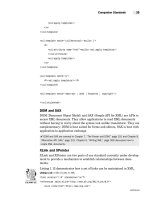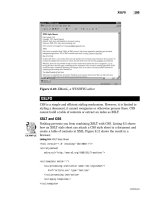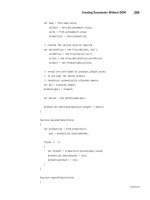Artificial intelligence by example develop machine intelligence from scratch using real artificial intelligence use cases
Bạn đang xem bản rút gọn của tài liệu. Xem và tải ngay bản đầy đủ của tài liệu tại đây (17.87 MB, 643 trang )
Artificial Intelligence
By Example
Develop machine intelligence from scratch using real artificial intelligence use cases
Denis Rothman
BIRMINGHAM - MUMBAI
Artificial Intelligence By Example
Copyright © 2018 Packt Publishing
All rights reserved. No part of this book may be reproduced, stored in a retrieval system, or transmitted in any form or by any means, without the prior written
permission of the publisher, except in the case of brief quotations embedded in critical articles or reviews.
Every effort has been made in the preparation of this book to ensure the accuracy of the information presented. However, the information contained in this book is
sold without warranty, either express or implied. Neither the author, nor Packt Publishing or its dealers and distributors, will be held liable for any damages caused or
alleged to have been caused directly or indirectly by this book.
Packt Publishing has endeavored to provide trademark information about all of the companies and products mentioned in this book by the appropriate use of capitals.
However, Packt Publishing cannot guarantee the accuracy of this information.
Commissioning Editor: Pravin Dhandre
Acquisition Editor: Tushar Gupta
Content Development Editor: M ayur Pawanikar
Technical Editor: Prasad Ramesh
Copy Editor: Vikrant Phadkay
Project Coordinator: Nidhi Joshi
Proofreader: Safis Editing
Indexer: Tejal Daruwale Soni
Graphics: Tania Dutta
Production Coordinator: Aparna Bhagat
First published: M ay 2018
Production reference: 1290518
Published by Packt Publishing Ltd.
Livery Place
35 Livery Street
Birmingham
B3 2PB, UK.
ISBN 978-1-78899-054-7
www.packtpub.com
To my family and friends for bringing me joy on the good days
and comfort on the bad ones.
-Denis Rothm
mapt.io
Mapt is an online digital library that gives you full access to over 5,000 books and videos, as well as
industry leading tools to help you plan your personal development and advance your career. For more
information, please visit our website.
Why subscribe?
Spend less time learning and more time coding with practical eBooks and Videos from over
4,000 industry professionals
Improve your learning with Skill Plans built especially for you
Get a free eBook or video every month
Mapt is fully searchable
Copy and paste, print, and bookmark content
PacktPub.com
Did you know that Packt offers eBook versions of every book published, with PDF and ePub files
available? You can upgrade to the eBook version at www.PacktPub.com and as a print book customer, you
are entitled to a discount on the eBook copy. Get in touch with us at for more
details.
At www.PacktPub.com, you can also read a collection of free technical articles, sign up for a range of free
newsletters, and receive exclusive discounts and offers on Packt books and eBooks.
Contributors
About the author
Denis Rothman graduated from l'Université Paris-Sorbonne and l'Université Paris-Diderot, writing
one of the very first word2matrix embedding solutions. He began his career authoring one of the first
AI cognitive NLP chatbots applied as a language teacher for Moët et Chandon and other companies.
He authored an AI resource optimizer for IBM and apparel producers. He then authored an Advanced
Planning and Scheduling (APS) solution used worldwide.
I want to thank the corporations who trusted me from the start to deliver artificial intelligence solutions and share the risks of
continuous innovation. I also thank my family, who believed I would make it big at all times.
About the reviewers
Armando Fandango creates AI-powered products by leveraging his expertise in deep learning,
machine learning, distributed computing, and computational methods. He advises Owen.ai Inc., Real
Engagement, and Loyalty Inc. on AI product strategy. He founded NeuraSights to create insights using
neural networks. He was the chief data scientist and CTO for Epic Engg., Consulting Group LLC, and
director of data science for Sonobi. He has advised high-tech startups as an AI expert and advisory
board member.
Nicolas Guet is a financial controller at GRDF. He was a project leader for ENGIE and a SAP BI
consultant for Capgemini.
He graduated from Université Pierre et Marie Curie (Paris VI) and Université Paris Sud (Paris XI).
He also designed a decision-making tool in Java that was part of an AI Advanced Planning System,
managing hundreds of thousands of orders for 100+ suppliers worldwide. He is dedicated to
promoting sustainable energy and smart grids.
Jérémie Rothman is an IT project manager at the French National Forest Office (ONF). He was an
I T consultant for TCS France and worked on a Total SA route optimizing project. He graduated
from Université Paris 1 Panthéon Sorbonne in economics and holds a degree in software mathematics
(Université Paris 5 René Descartes).
He designed a Nash equilibrium theory of games algorithm to optimize warehouse locations for an AI
Advanced Planning System (APS). The APS program is used to this day.
Packt is searching for authors like you
If you're interested in becoming an author for Packt, please visit authors.packtpub.com and apply today.
We have worked with thousands of developers and tech professionals, just like you, to help them
share their insight with the global tech community. You can make a general application, apply for a
specific hot topic that we are recruiting an author for, or submit your own idea.
Table of Contents
Title Page
Copyright and Credits
Artificial Intelligence By Example
Dedication
Packt Upsell
Why subscribe?
PacktPub.com
Contributors
About the author
About the reviewers
Packt is searching for authors like you
Preface
Who this book is for
What this book covers
To get the most out of this book
Download the example code files
Download the color images
Code in Action
Conventions used
Get in touch
Reviews
1.
Become an Adaptive Thinker
Technical requirements
How to be an adaptive thinker
Addressing real-life issues before coding a solution
Step 1 – MDP in natural language
Step 2 – the mathematical representation of the Bellman equation and MDP
From MDP to the Bellman equation
Step 3 – implementing the solution in Python
The lessons of reinforcement learning
How to use the outputs
Machine learning versus traditional applications
Summary
Questions
Further reading
2.
Think like a Machine
Technical requirements
Designing datasets – where the dream stops and the hard work begins
Designing datasets in natural language meetings
Using the McCulloch-Pitts neuron
The McCulloch-Pitts neuron
The architecture of Python TensorFlow
Logistic activation functions and classifiers
Overall architecture
Logistic classifier
Logistic function
Softmax
Summary
Questions
Further reading
3.
Apply Machine Thinking to a Human Problem
Technical requirements
Determining what and how to measure
Convergence
Implicit convergence
Numerical – controlled convergence
Applying machine thinking to a human problem
Evaluating a position in a chess game
Applying the evaluation and convergence process to a business problem
Using supervised learning to evaluate result quality
Summary
Questions
Further reading
4.
Become an Unconventional Innovator
Technical requirements
The XOR limit of the original perceptron
XOR and linearly separable models
Linearly separable models
The XOR limit of a linear model, such as the original perceptron
Building a feedforward neural network from scratch
Step 1 – Defining a feedforward neural network
Step 2 – how two children solve the XOR problem every day
Implementing a vintage XOR solution in Python with an FNN and backpropagation
A simplified version of a cost function and gradient descent
Linear separability was achieved
Applying the FNN XOR solution to a case study to optimize subsets of data
Summary
Questions
Further reading
5.
Manage the Power of Machine Learning and Deep Learning
Technical requirements
Building the architecture of an FNN with TensorFlow
Writing code using the data flow graph as an architectural roadmap
A data flow graph translated into source code
The input data layer
The hidden layer
The output layer
The cost or loss function
Gradient descent and backpropagation
Running the session
Checking linear separability
Using TensorBoard to design the architecture of your machine learning and deep learning solutions
Designing the architecture of the data flow graph
Displaying the data flow graph in TensorBoard
The final source code with TensorFlow and TensorBoard
Using TensorBoard in a corporate environment
Using TensorBoard to explain the concept of classifying customer products to a CEO
Will your views on the project survive this meeting?
Summary
Questions
Further reading
References
6.
Don't Get Lost in Techniques – Focus on Optimizing Your Solutions
Technical requirements
Dataset optimization and control
Designing a dataset and choosing an ML/DL model
Approval of the design matrix
Agreeing on the format of the design matrix
Dimensionality reduction
The volume of a training dataset
Implementing a k-means clustering solution
The vision
The data
Conditioning management
The strategy
The k-means clustering program
The mathematical definition of k-means clustering
Lloyd's algorithm
The goal of k-means clustering in this case study
The Python program
1 – The training dataset
2 – Hyperparameters
3 – The k-means clustering algorithm
4 – Defining the result labels
5 – Displaying the results – data points and clusters
Test dataset and prediction
Analyzing and presenting the results
AGV virtual clusters as a solution
Summary
Questions
Further reading
7.
When and How to Use Artificial Intelligence
Technical requirements
Checking whether AI can be avoided
Data volume and applying k-means clustering
Proving your point
NP-hard – the meaning of P
NP-hard – The meaning of non-deterministic
The meaning of hard
Random sampling
The law of large numbers – LLN
The central limit theorem
Using a Monte Carlo estimator
Random sampling applications
Cloud solutions – AWS
Preparing your baseline model
Training the full sample training dataset
Training a random sample of the training dataset
Shuffling as an alternative to random sampling
AWS – data management
Buckets
Uploading files
Access to output results
SageMaker notebook
Creating a job
Running a job
Reading the results
Recommended strategy
Summary
Questions
Further reading
8.
Revolutions Designed for Some Corporations and Disruptive Innovations for Small to Large Companies
Technical requirements
Is AI disruptive?
What is new and what isn't in AI
AI is based on mathematical theories that are not new
Neural networks are not new
Cloud server power, data volumes, and web sharing of the early 21st century started to make
AI disruptive
Public awareness contributed to making AI disruptive
Inventions versus innovations
Revolutionary versus disruptive solutions
Where to start?
Discover a world of opportunities with Google Translate
Getting started
The program
The header
Implementing Google's translation service
Google Translate from a linguist's perspective
Playing with the tool
Linguistic assessment of Google Translate
Lexical field theory
Jargon
Translating is not just translating but interpreting
How to check a translation
AI as a new frontier
Lexical field and polysemy
Exploring the frontier – the program
k-nearest neighbor algorithm
The KNN algorithm
The knn_polysemy.py program
Implementing the KNN compressed function in Google_Translate_Customized.py
Conclusions on the Google Translate customized experiment
The disruptive revolutionary loop
Summary
Questions
Further reading
9.
Getting Your Neurons to Work
Technical requirements
Defining a CNN
Defining a CNN
Initializing the CNN
Adding a 2D convolution
Kernel
Intuitive approach
Developers' approach
Mathematical approach
Shape
ReLu
Pooling
Next convolution and pooling layer
Flattening
Dense layers
Dense activation functions
Training a CNN model
The goal
Compiling the model
Loss function
Quadratic loss function
Binary cross-entropy
Adam optimizer
Metrics
Training dataset
Data augmentation
Loading the data
Testing dataset
Data augmentation
Loading the data
Training with the classifier
Saving the model
Next steps
Summary
Questions
Further reading and references
10.
Applying Biomimicking to Artificial Intelligence
Technical requirements
Human biomimicking
TensorFlow, an open source machine learning framework
Does deep learning represent our brain or our mind?
A TensorBoard representation of our mind
Input data
Layer 1 – managing the inputs to the network
Weights, biases, and preactivation
Displaying the details of the activation function through the preactivation process
The activation function of Layer 1
Dropout and Layer 2
Layer 2
Measuring the precision of prediction of a network through accuracy values
Correct prediction
accuracy
Cross-entropy
Training
Optimizing speed with Google's Tensor Processing Unit
Summary
Questions
Further reading
11.
Conceptual Representation Learning
Technical requirements
Generate profit with transfer learning
The motivation of transfer learning
Inductive thinking
Inductive abstraction
The problem AI needs to solve
The Γ gap concept
Loading the Keras model after training
Loading the model to optimize training
Loading the model to use it
Using transfer learning to be profitable or see a project stopped
Defining the strategy
Applying the model
Making the model profitable by using it for another problem
Where transfer learning ends and domain learning begins
Domain learning
How to use the programs
The trained models used in this section
The training model program
GAP – loaded or unloaded
GAP – jammed or open lanes
The gap dataset
Generalizing the Γ(gap conceptual dataset)
Generative adversarial networks
Generating conceptual representations
The use of autoencoders
The motivation of conceptual representation learning meta-models
The curse of dimensionality
The blessing of dimensionality
Scheduling and blockchains
Chatbots
Self-driving cars
Summary
Questions
Further reading
12.
Automated Planning and Scheduling
Technical requirements
Planning and scheduling today and tomorrow
A real-time manufacturing process
Amazon must expand its services to face competition
A real-time manufacturing revolution
CRLMM applied to an automated apparel manufacturing process
An apparel manufacturing process
Training the CRLMM
Generalizing the unit-training dataset
Food conveyor belt processing – positive pγ and negative nγ&#x
A0;gaps
Apparel conveyor belt processing – undetermined gaps
The beginning of an abstract notion of gaps
Modifying the hyperparameters
Running a prediction program
Building the DQN-CRLMM
A circular process
Implementing a CNN-CRLMM to detect gaps and optimize
Q-Learning – MDP
MDP inputs and outputs
The input is a neutral reward matrix
The standard output of the MDP function
A graph interpretation of the MDP output matrix
The optimizer
The optimizer as a regulator
Implementing Z – squashing the MDP result matrix
Implementing Z – squashing the vertex weights vector
Finding the main target for the MDP function
Circular DQN-CRLMM – a stream-like system that never starts nor ends
Summary
Questions
Further reading
13.
AI and the Internet of Things (IoT)
Technical requirements
The Iotham City project
Setting up the DQN-CRLMM model
Training the CRLMM
The dataset
Training and testing the model
Classifying the parking lots
Adding an SVM function
Motivation – using an SVM to increase safety levels
Definition of a support vector machine
Python function
Running the CRLMM
Finding a parking space
Deciding how to get to the parking lot
Support vector machine
The itinerary graph
The weight vector
Summary
Questions
Further reading
References
14.
Optimizing Blockchains with AI
Technical requirements
Blockchain technology background
Mining bitcoins
Using cryptocurrency
Using blockchains
Using blockchains in the A-F network
Creating a block
Exploring the blocks
Using naive Bayes in a blockchain process
A naive Bayes example
The blockchain anticipation novelty
The goal
Step 1 the dataset
Step 2 frequency
Step 3 likelihood
Step 4 naive Bayes equation
Implementation
Gaussian naive Bayes
The Python program
Implementing your ideas
Summary
Questions
Further reading
15.
Cognitive NLP Chatbots
Technical requirements
IBM Watson
Intents
Testing the subsets
Entities
Dialog flow
Scripting and building up the model
Adding services to a chatbot
A cognitive chatbot service
The case study
A cognitive dataset
Cognitive natural language processing
Activating an image + word cognitive chat
Solving the problem
Implementation
Summary
Questions
Further reading
16.
Improve the Emotional Intelligence Deficiencies of Chatbots
Technical requirements
Building a mind
How to read this chapter
The profiling scenario
Restricted Boltzmann Machines
The connections between visible and hidden units
Energy-based models
Gibbs random sampling
Running the epochs and analyzing the results
Sentiment analysis
Parsing the datasets
Conceptual representation learning meta-models
Profiling with images
RNN for data augmentation
RNNs and LSTMs
RNN, LSTM, and vanishing gradients
Prediction as data augmentation
Step1 – providing an input file
Step 2 – running an RNN
Step 3 – producing data augmentation
Word embedding
The Word2vec model
Principal component analysis
Intuitive explanation
Mathematical explanation
Variance
Covariance
Eigenvalues and eigenvectors
Creating the feature vector
Deriving the dataset
Summing it up
TensorBoard Projector
Using Jacobian matrices
Summary
Questions
Further reading
17.
Quantum Computers That Think
Technical requirements
The rising power of quantum computers
Quantum computer speed
Defining a qubit
Representing a qubit
The position of a qubit
Radians, degrees, and rotations
Bloch sphere
Composing a quantum score
Quantum gates with Quirk
A quantum computer score with Quirk
A quantum computer score with IBM Q
A thinking quantum computer
Representing our mind's concepts
Expanding MindX's conceptual representations
Concepts in the mind-dataset of MindX
Positive thinking
Negative thinking
Gaps
Distances
The embedding program
The MindX experiment
Preparing the data
Transformation Functions – the situation function
Transformation functions – the quantum function
Creating and running the score
Using the output
IBM Watson and scripts
Summary
Questions
Further reading
Answers to the Questions
Chapter 1 – Become an Adaptive Thinker
Chapter 2 – Think like a Machine
Chapter 3 – Apply Machine Thinking to a Human Problem
Chapter 4 – Become an Unconventional Innovator
Chapter 5 – Manage the Power of Machine Learning and Deep Learning
Chapter 6 – Don't Get Lost in Techniques, Focus on Optimizing Your Solutions
Chapter 7 – When and How to Use Artificial Intelligence
Chapter 8 – Revolutions Designed for Some Corporations and Disruptive Innovations for Small to L
arge Companies
Chapter 9 – Getting Your Neurons to Work
Chapter 10 – Applying Biomimicking to AI
Chapter 11 – Conceptual Representation Learning
Chapter 12 – Automated Planning and Scheduling
Chapter 13 – AI and the Internet of Things
Chapter 14 – Optimizing Blockchains with AI
Chapter 15 – Cognitive NLP Chatbots
Chapter 16 – Improve the Emotional Intelligence Deficiencies of Chatbots
Chapter 17 – Quantum Computers That Think
Preface
This book will take you through all of the main aspects of artificial intelligence:
The theory of machine learning and deep learning
Mathematical representations of the main AI algorithms
Real life case studies
Tens of opensource Python programs using TensorFlow, TensorBoard, Keras and more
Cloud AI Platforms: Google, Amazon Web Services, IBM Watson and IBM Q to introduce you
to quantum computing
An Ubuntu VM containing all the opensource programs that you can run in one-click
Online videos
This book will take you to the cutting edge and beyond with innovations that show how to improve
existing solutions to make you a key asset as a consultant, developer, professor or any person
involved in artificial intelligence.
Who this book is for
This book contains the main artificial intelligence algorithms on the market today. Each machine
learning and deep learning solution is illustrated by a case study and an open source program
available on GitHub.
Project managers and consultants: To understand how to manage AI input datasets, make a
solution choice (cloud platform or development), and use the outputs of an AI system.
Teachers, students, and developers: This book provides an overview of many key AI
components, with tens of Python sample programs that run on Windows and Linux. A VM is
available as well.
Anybody who wants to understand how AI systems are built and what they are used for.









